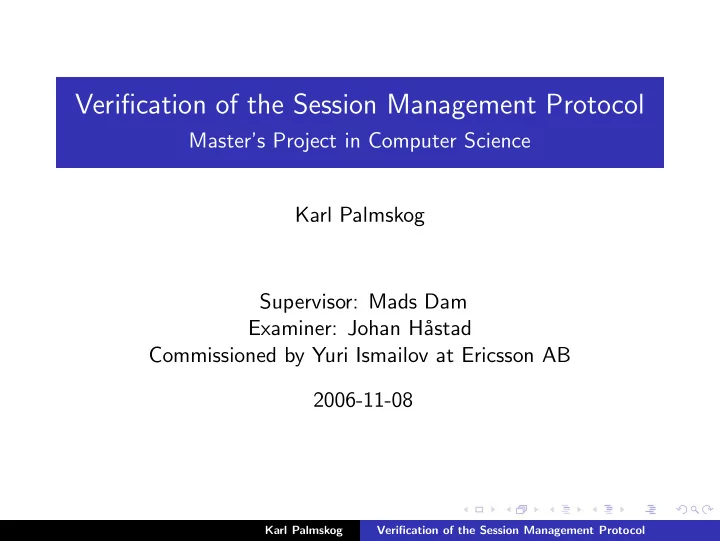

Verification of the Session Management Protocol Master’s Project in Computer Science Karl Palmskog Supervisor: Mads Dam Examiner: Johan H˚ astad Commissioned by Yuri Ismailov at Ericsson AB 2006-11-08 Karl Palmskog Verification of the Session Management Protocol
Session Layer Resurgence Problem situation ◮ Demand for new network services ◮ Aging Internet architecture ◮ Need to handle mobility and nomadicity ◮ Lots of extensions of TCP/IP: MIP, HIP, IPSec, . . . Proposed solution ◮ Adopt a more flexible view of the protocol stack ◮ Introduce new functionality at the session layer ◮ Use event-driven reconfiguration and state management Karl Palmskog Verification of the Session Management Protocol
Session Layer Resurgence Karl Palmskog Verification of the Session Management Protocol
Session Layer Resurgence Session layer components ◮ Event collector/dispatcher ◮ Preferences/rules database ◮ Socket rebind extension ◮ Session API ◮ TCP state controller ◮ Session Management Protocol (SMP) Karl Palmskog Verification of the Session Management Protocol
Session Layer Resurgence Session-enabled Session-enabled Legacy application application application Session Management API Session Management Protocol Event collector Rebind-enhanced socket API and dispatcher TCP state Preferences and controller rules database Rebind across Transport layer protocols the stack Network layer protocols Karl Palmskog Verification of the Session Management Protocol
Session Layer Resurgence Session Management Protocol ◮ Data integrity for sessions ◮ Keep track of communication state ◮ Send and and receive context updates Background ◮ Developed as a part of an earlier master’s project ◮ Proof-of-concept implementation in the Linux kernel ◮ Vital part of the session layer Karl Palmskog Verification of the Session Management Protocol
Problem and aim Problem ◮ SMP correctness is critical ◮ Data integrity must be preserved ◮ Design must be deadlock-free Aim 1. Understand SMP and describe it formally 2. Specify the correctness of the protocol 3. Prove that the protocol satisfies the specification Karl Palmskog Verification of the Session Management Protocol
Method Model checking ◮ Provide system model M , specification Φ ◮ Check automatically whether M satisfies Φ ◮ Use abstraction to reduce state space Choices ◮ Modelling language: Promela ◮ Specification language: Linear Temporal Logic ◮ Model checker: Spin Karl Palmskog Verification of the Session Management Protocol
Session Management Protocol SMP service provisions ◮ Provide reliable data transfer between endpoints... ◮ ...despite intermittent connectivity in both space and time SMP channels and message types ◮ Data channel ◮ data — application data ◮ checkpoint — communication state data ◮ Control channel ◮ resume — request session resumption ◮ resume ok — confirm session resumption ◮ resume denied — deny session resumption ◮ suspend — sender has suspended Karl Palmskog Verification of the Session Management Protocol
Session Management Protocol State machine T19 T1: Network lost T8 T2: User suspends; send suspend T3: Received resume; rebind SUSPENDED T4: Received suspend T5: User suspends T6: Received resume T2 T9 T7: Network changed T5 T4 T8: Received resume; send resume_denied ACTIVE T9: User resumes T7 T1 T10: Sent resume_ok; rollback T3 T11: Failed to send resume_ok T13 T11 READY_RESUME T12: Sent resume T12 T13: Failed to send resume T10 T6 T14: Received resume_ok T15: Received resume_denied T17 T16 T18 T15 T16: Network changed; rebind T17: Received resume; initiator SENT_RESUME T18: Received resume; not initiator T14 T19: Network lost; change interface Karl Palmskog Verification of the Session Management Protocol
Results Verification of the checkpoint mechanism ◮ Lets network endpoints agree on resumeable states ◮ Endpoints send checkpoint messages when buffers fill up ◮ Cannot create new checkpoint until other endpoint responds ◮ Specification: processes always have a common checkpoint Design flaw ◮ A checkpoint request can be interpreted as a response ◮ Possible to get ambiguously defined states in some situations ◮ Solution: only allow one endpoint to send checkpoint requests Karl Palmskog Verification of the Session Management Protocol
Results Noninitiator:2 23 Initiator:1 34 2!data,0,0 37 1!data,0,0 44 2!data,0,0 50 62 69 2!cp,2,2 75 84 1!data,0,0 87 104 2!data,0,0 107 1!cp,2,2 115 122 Karl Palmskog Verification of the Session Management Protocol
Results State machine correctness ◮ Safety: if a session is resumed, it is resumed properly ◮ Liveness: there are no deadlocks State machine model ◮ Add control channels and states to checkpoint model ◮ Use Promela ’s channel over channel feature for mobility ◮ Protocol changes due to changes in the checkpoint mechanism Verification results ◮ Exhaustively verified for some parameters ◮ Many partial state-space searches Karl Palmskog Verification of the Session Management Protocol
Conclusions and future work Conclusions ◮ Produced unambiguous specification of the protocol ◮ Detection and correction of a design flaw ◮ SMP reliability has increased Future work ◮ Implement changes and test them ◮ Verify other parts of the session layer design ◮ Investigate SMP/TCP interaction “Every protocol should be considered incorrect until the opposite is proven.” —Gerard J. Holzmann, author of Spin Karl Palmskog Verification of the Session Management Protocol
More information Protocol models and thesis available at: http://www.palmskog.net/exjobb Session Layer Resurgence: Towards Mobile, Disconnection- and Delay-tolerant Communication. Accepted to the 4th European Conference on Universal Multiservice Networks (ECUMN’2007), February 2007. http://www.irit.fr/ecumn07 Karl Palmskog Verification of the Session Management Protocol
Recommend
More recommend